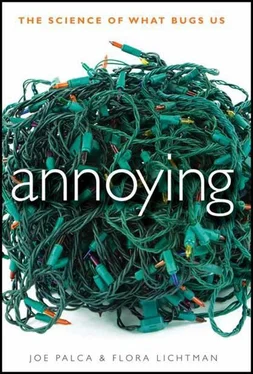Detection also matters, says Herz. Not all humans are thought to have the same odor receptors, meaning that not everyone will smell the same scents. This variation in receptors can make people sensitive to certain scents. For example, if the smell of skunks is particularly annoying to you, it may be because you have more receptors that are sensitive to thiols. What might smell moderately strong to one person could make you gag if you have more receptors for that odor. “It has to do with the intensity,” Herz says. “Even your favorite piece of music is aversive if it’s blaring.” Herz says that this is an instance where there are innate differences in response to smell.
Herz argues that judgments about particular smells come less from an inherent like or dislike but more from the context. She has investigated how association affects our perception of a scent. In one particularly memorable study published in the journal Perception , Herz and Julia von Clef asked eighty undergraduates to do a smell test on some “ambiguous” scents and rate their pleasantness. {21} 21 4. Rachel S. Herz and Julia von Clef, “The Influence of Verbal Labeling on the Perception of Odors: Evidence for Olfactory Illusions?” Perception 30(3) (2001): 381–391.
The scents were labeled differently in various sessions. For example, violet leaf was labeled “fresh cucumber” in one session and “mildew” in another; pine oil was “Christmas tree” in one and “spray disinfectant” in another. The real kicker was a 1:1 chemical composition of isovaleric and butyric acids that was labeled “parmesan cheese” in one experiment and “vomit” in another.
The researchers found that the labels made a big difference between annoying and appetizing. People strongly liked the smell of what they thought was parmesan but were repelled by the same odor when they were told it was vomit. This fits in with Herz’s theory that our preference for smells is largely dependent on learning and context. On the matter of skunk spray, Herz argues that certain animals, those specifically adapted to a particular habitat, do seem to be born with innate olfactory responses. She argues that humans, as generalists, are different. We’re better off being able to learn quickly whether a smell is bad or good, rather than being preprogrammed to avoid a smell.
Herz suggests that our collective dislike of skunk spray may also be related to the fact that it’s irritating physically. Smells can have feelings associated with them. Menthol feels cool. Ammonia burns. Skunk spray hurts. The feelings associated with smells are picked up by nerve cells in our noses and eyes—these receptors are responsible for the tears we cry over raw onions. Herz suggests that for compounds such as ammonia and thiols in skunk spray, we don’t separate the smell from the sensation. “In actuality, what we’re being repelled by or annoyed by is the irritancy, but we say we don’t like the ‘odor.’”
Skunk spray becomes more threatening in very high doses. There have been reports of dogs dying as a result of being sprayed, according to Wood and Dragoo, although this appears to have more to do with the consistency of the spray than its scent—the oil is thought to coat their lungs. Humans have suffered, too. In 1881, Dr. W. B. Conway, at the Virginia Agricultural and Mechanical College in Blacksburg, recounted a story in the Virginia Medical Monthly about the unfortunate victim of a practical joke. A few college boys “secured a two-ounce bottle of the perfume from the skunk,” Conway wrote. The boys entered the victim’s room, held him down, and forced him to sniff the spray straight from the bottle. “I could not ascertain what amount was administered,” Conway wrote. “However, when I reached him I found the following symptoms: A total unconsciousness, relaxation of the muscular system, extremities cool, pupils natural, breathing normal, pulse 65, temperature 94; in which condition he remained for one hour.” To treat the comalike symptoms, the doctor “administered small quantities of whisky at short intervals per orem , with some difficulty getting him to swallow.” It took about an hour and who knows how many whiskeys, but the boy was eventually revived. The take-home point: like many annoyances, skunk spray is usually irritating but can become sickening in high doses.
Whether we are repelled by skunk spray because of its irritancy, because of a cultural construct, or because of an evolutionary predisposition, the annoying quotient doesn’t change much. It’s annoying no matter why it’s annoying, and part of that is our sensitivity to these chemicals. Our noses can detect skunk spray at relatively low levels—about ten molecules per billion.
It’s not quite clear why we’re able to detect thiols in such low doses. One theory has to do with how the thiols bond with the receptors in our noses. Block says, “There’s no reason why a very low level of a sulfur compound should fit particularly better in an enzyme cavity if you use the old-fashioned lock and key model for enzymes and substrates. There’s no simple explanation for the detection of thiols at extraordinarily low levels, unless you invoke some sort of process where chemically the binding should be extremely good.” One idea is that metals aid in the olfactory binding: “metals, such as copper, do bind with sulfur very, very well,” says Block. “Is it simply a coincidence that a particularly foul-smelling component in skunk spray, 2-quinolinethiol, is also known to strongly bind to metals?” Block asks. Metals in our olfactory receptors could act like glue, helping the molecules attach more securely to the receptors.
There is no question that once those molecules are lodged in a receptor, they’re hard to get out. This leads to olfactory fatigue. The receptors in your nose tire of sending signals. The neurons stop firing, and the brain takes that to mean the odor is gone. This is why tomato juice is thought to work as a skunk spray remedy, says chemist Paul Krebaum. “There’s nothing in tomato juice that takes the smell away. It’s a total myth. What happens to most people—by the time they’re done washing their pets in tomato juice—is that they’ve been exposed to the skunk spray for so long that they’ve developed olfactory fatigue.” Meanwhile, the tomato juice locks into other receptors, causing them to fire. The skunk smell is masked by the tomato smell.
Although tomato juice won’t do the trick, there is something that will. “I was working on a project where we were etching grains of zinc sulfide with acid, and it was producing hydrogen sulfide gas as the by-product,” says Paul Krebaum. It stank. People started to complain. “I needed a way of absorbing this hydrogen waste product as it was being generated.” The solution was a chemical reaction: alkaline hydrogen peroxide transformed those stinky molecules into something else. After his colleague’s cat had a run-in with a skunk, Krebaum wondered whether his remedy might work on the skunk spray, too, because the thiol molecules are shaped like those of hydrogen sulfide. “So I made up a milder version for him,” Krebaum says, and it worked. Recognizing the utility of the discovery, Krebaum wrote to Chemical and Engineering News and the remedy was published in an article titled “Lab Method Deodorizes a Skunk-Afflicted Pet.” {22} 22 5. Paul Krebaum, “Lab Method Deodorizes a Skunk-Afflicted Pet,” Chemical & Engineering News 71(42) (1993): 90.
The story got picked up by the Chicago Tribune , and the rest is history. Now the recipe is available on Krebaum’s Web site. {23} 23 6. The recipe and directions can be found at http://home.earthlink.net/~skunkremedy/home/ .
Here’s how it works: Mix 3 percent hydrogen peroxide with soap and baking soda, apply it to your skunked pet, and rinse. It works by a process called oxidation. The hydrogen peroxide reacts with the thiol to produce a disulfide, which is much less smelly. If the reaction continues, the disulfide turns into sulfonic acid with the addition of more oxygen to the sulfur group of the thiol. Block also uses oxidizing agents for odor elimination in his lab. [1] Just like William Wood, Eric Block’s research in garlic chemistry had colleagues downwind from his fume hood flaring their nostrils. “I was contacted by our president’s office about a strong pizza smell in his office. The solution was to invest several million dollars in new fume stacks to transport the fume hood exhaust gases higher up in the atmosphere away from campus offices!”
“We use this in the laboratory because we work with a lot of thiols, and you can’t even flush things down the drain without causing mischief elsewhere in the building because the drains have vents and so forth. You could use peroxide, but bleach is much more effective. Now bleach is not a good remedy for a pet, nor would you want to use concentrated hydrogen peroxide. But a 3 percent concentration is safe.” (Despite the peroxide, Krebaum hasn’t gotten many complaints of fur bleaching.)
Читать дальше












